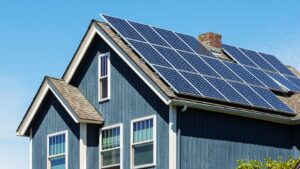As the world tilts towards sustainable living, solar panels stand out as a beacon of renewable energy. Homeowners across the globe are turning to solar energy not just to cut down on electricity bills but also to reduce their carbon footprint. The burning question remains: Can solar panels truly power an entire house?
Can Solar Panels Power a Whole House
Factors Influencing Solar Energy Efficiency
 Solar panels can indeed power a whole house, but the extent to which they do depends on several factors that influence the efficiency of the solar energy system. Understanding these factors helps homeowners gauge whether solar power will meet their energy needs effectively.
Solar panels can indeed power a whole house, but the extent to which they do depends on several factors that influence the efficiency of the solar energy system. Understanding these factors helps homeowners gauge whether solar power will meet their energy needs effectively.
-
Geographical Location: Homes located in areas with high sunlight exposure, such as the southwestern United States, benefit greatly from solar power. More sunlight means more energy production, enhancing the ability to power a house entirely on solar energy.
-
Weather Conditions: Solar panels function optimally under clear, sunny skies. Frequent cloudy, rainy, or snowy days can reduce the energy output of solar panels, impacting their efficiency.
-
Solar Panel Quality: High-quality solar panels with a high efficiency rating convert more sunlight into electricity. They’re more capable of meeting the energy demands of a whole house.
-
Energy Consumption Patterns: The typical energy usage of a household also dictates the viability of solar panels powering the whole house. Homes with lower energy consumption will find it easier to transition to solar power.
-
System Design and Installation: Proper installation and design of the solar energy system, including the right sizing and orientation of solar panels, play a crucial role. If the system is designed to accommodate peak energy loads and optimally angled to capture maximum sunlight, it’s more likely to power a house completely.
Evaluating Solar Power Capacity Needs
Assessing Household Energy Consumption
 Evaluating the total energy usage of a household is the first step in determining whether solar panels can power the entire home. Homeowners need to gather data on their electricity consumption, which is usually measured in kilowatt-hours (kWh). Examining past utility bills over the course of a year provides an accurate estimation, as energy use tends to vary with the seasons. Major appliances such as refrigerators, washing machines, and HVAC systems are significant contributors to overall energy demand. By aggregating the energy usage of these appliances, homeowners gain a clearer understanding of their total energy requirements.
Evaluating the total energy usage of a household is the first step in determining whether solar panels can power the entire home. Homeowners need to gather data on their electricity consumption, which is usually measured in kilowatt-hours (kWh). Examining past utility bills over the course of a year provides an accurate estimation, as energy use tends to vary with the seasons. Major appliances such as refrigerators, washing machines, and HVAC systems are significant contributors to overall energy demand. By aggregating the energy usage of these appliances, homeowners gain a clearer understanding of their total energy requirements.
Calculating Required Solar Panel Output
Once the total energy consumption is known, the next step involves calculating the necessary output of solar panels to meet this demand. The average solar panel produces between 250 to 400 watts of power; however, the actual output depends on various factors including panel efficiency, sunlight exposure, and panel orientation. To find the total wattage required, homeowners must divide their total energy consumption in kWh by the number of hours of peak sunlight their location receives. This calculation gives a rough estimate of the required solar panel output to fully power the home. For instance, a home that uses 10,000 kWh annually in a region with approximately 4 hours of sunlight per day would need about 6.85 kW of solar production capacity.
Installation and Maintenance of Solar Systems
 Ensuring optimal performance from a solar power setup involves efficient installation and regular maintenance. Homeowners install solar panels according to specific guidelines that ensure the maximum absorption of sunlight. Professional installers evaluate factors like roof angle, orientation, and structural integrity. They position panels to face the optimal direction, which, in the Northern Hemisphere, is typically south.
Ensuring optimal performance from a solar power setup involves efficient installation and regular maintenance. Homeowners install solar panels according to specific guidelines that ensure the maximum absorption of sunlight. Professional installers evaluate factors like roof angle, orientation, and structural integrity. They position panels to face the optimal direction, which, in the Northern Hemisphere, is typically south.
Regular maintenance enhances the system’s longevity and efficiency. Homeowners should inspect panels annually for any dirt, debris, or damage. Cleaning panels regularly prevents the buildup of materials that could block sunlight and decrease efficiency. Experts also recommend checking the inverter and other system components to ensure smooth operation.
Financial Aspects of Solar Energy Adoption
Solar energy adoption offers substantial financial benefits if homeowners understand the upfront costs and long-term savings. The initial cost of a solar power system includes purchasing the panels, inverters, and paying for installation, which collectively can range from $15,000 to $25,000. The specific cost depends on the system size and the home’s energy needs.